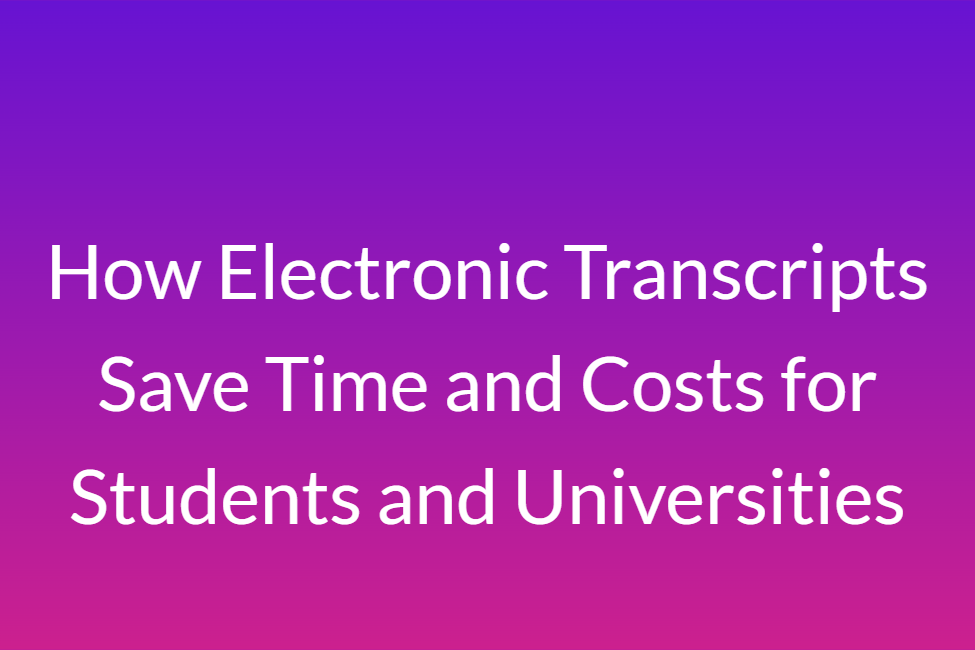How Electronic Transcripts Save Time and Costs for Students and Universities

The modern academic landscape demands efficiency, speed, and security. Traditional paper-based transcript systems have long been plagued with delays, high expenses, and logistical hurdles that burden both students and educational institutions. With the arrival of Electronic transcripts, this scenario has been transformed. They streamline document sharing, reduce administrative bottlenecks, and eliminate unnecessary costs while ensuring authenticity and reliability.
The Hidden Challenges of Paper Transcripts
For decades, students relied on paper transcripts to apply for higher education, jobs, or professional certifications. This system was often riddled with inefficiencies: long queues at administrative offices, courier delays, lost or damaged documents, and high postal charges for international deliveries. These delays often put students at risk of missing application deadlines.
For institutions, managing manual transcript requests required significant time and resources. Staff spent countless hours printing, sealing, mailing, and responding to queries, which increased workload and operating expenses.
The Shift to Digital Efficiency
Electronic transcripts have revolutionized this process. By allowing secure, direct online requests and digital delivery, institutions save valuable time that was once spent on manual handling. At the same time, students receive their transcripts faster, often within days, ensuring that deadlines are met without stress.
The digital system also improves accuracy by reducing human errors such as misspelled names, incomplete records, or misplaced documents.
Faster Application Processes for Students
For students applying to universities or employers abroad, every day matters. Missing an admission cycle or job deadline can mean waiting months or even a year. Electronic transcripts accelerate the process by ensuring instant delivery to designated recipients.
This speed not only saves time but also reduces the anxiety and uncertainty students often face during critical phases of their academic or career journey.
Cost Savings Through Elimination of Couriers
One of the most tangible benefits of electronic transcripts is cost savings. In the past, sending transcripts to multiple institutions meant paying separate courier charges for each copy. International delivery could cost students thousands over multiple applications.
Now, with electronic transcripts, students can send documents digitally at a fraction of the cost, no matter how many universities or agencies they apply to.
Efficiency for Universities and Colleges
From an institutional perspective, electronic transcripts drastically cut down on administrative workloads. Universities can process hundreds of transcript requests simultaneously without the need for manual printing and mailing.
This efficiency frees staff time for more meaningful academic and student support tasks, reducing burnout and improving institutional productivity.
Reduced Errors and Improved Accuracy
Human error was one of the most common issues with paper transcripts. Misfiled documents, incorrect addresses, or incomplete records often led to additional costs and wasted time.
Electronic transcripts solve this by automating the process. Institutions use secure digital platforms that validate student data, reducing the likelihood of mistakes. Accuracy benefits both students and recipients, ensuring smooth processing of applications.
Accessibility for Students in Remote Regions
Students living in rural or remote areas once faced additional costs and delays in accessing transcript services. Courier services often charged more for delivery in less accessible regions, further straining student budgets.
With electronic transcripts, students can request and send their documents online without traveling long distances or paying extra for courier fees. This makes education more accessible and inclusive.
Enhancing Global Mobility at Lower Costs
Students pursuing international opportunities previously bore significant financial burdens just to ensure their transcripts reached foreign institutions. Electronic transcripts enable global delivery without additional charges, allowing more students to apply abroad without financial strain.
This not only supports individual ambitions but also enhances global academic mobility by removing financial barriers.
Time-Saving for Employers and Agencies
Employers, credential evaluators, and government authorities also benefit from electronic transcripts. Verification becomes faster and more efficient, reducing waiting times for both students and organizations.
This streamlined process helps employers and agencies make quicker decisions, saving costs associated with delays and miscommunication.
Sustainability and Paperless Operations
Another important advantage is environmental sustainability. Printing and mailing thousands of transcripts consume paper, envelopes, and packaging materials. By switching to electronic transcripts, institutions reduce their carbon footprint and promote eco-friendly practices.
This aligns with global sustainability goals while also cutting down costs associated with paper and printing resources.
Reducing Student Stress and Repeated Costs
Students often had to pay extra fees when transcripts were lost or when additional copies were needed urgently. With electronic transcripts, these issues are virtually eliminated. Documents are securely stored digitally, ensuring that students can request additional copies anytime without incurring excessive costs.
This convenience helps students stay focused on their studies and career goals rather than being burdened by administrative challenges.
Long-Term Financial Benefits for Institutions
While implementing electronic transcript systems requires some initial investment, the long-term cost savings for institutions are significant. Reduced staff hours, lower material costs, and fewer errors translate into substantial budget efficiency.
These savings can be redirected toward improving student services, scholarships, or campus resources, creating a better educational environment.
The Future of Academic Cost Management
Electronic transcripts represent more than just convenience—they are a cost-management tool for the future of education. By cutting unnecessary expenses and saving time, they make education more affordable and accessible for all stakeholders. Students benefit from reduced financial strain, and universities can operate more efficiently in an increasingly digital-first world.
Read full Blog @ https://www.electronictranscripts.com/blog/why-transcript-certificates-are-a-must-have-in-your-education-journey/
About Us
Electronic Transcript provides a trusted platform for students and professionals to request, verify, and deliver their academic transcripts worldwide. Our secure and efficient services are accepted by universities, employers, and credential evaluation agencies across the globe. With a commitment to reliability and speed, we help applicants achieve their education and career goals without delays or complications.
- Art
- Causes
- Crafts
- Dance
- Drinks
- Film
- Fitness
- Food
- Games
- Gardening
- Health
- Home
- Literature
- Music
- Networking
- Other
- Party
- Religion
- Shopping
- Sports
- Theater
- Wellness




